Earth may seem huge from our vantage point, but it is actually a relatively small planet in our Solar System.

What is the solar system? Our solar system is the sun and all of the planets that orbit around it. It was formed 4.6 billion years ago from the collapse of a giant cloud made up of gas particles.

Our solar system as depicted.
Currently, we have identified 8 planets that orbit around the sun. The 4 closest ones to the sun are called terrestrial planets, and the 4 outermost are called the gas giants.

In this lesson, we’ll be learning about the different planets in our solar system.
Planets
Mercury
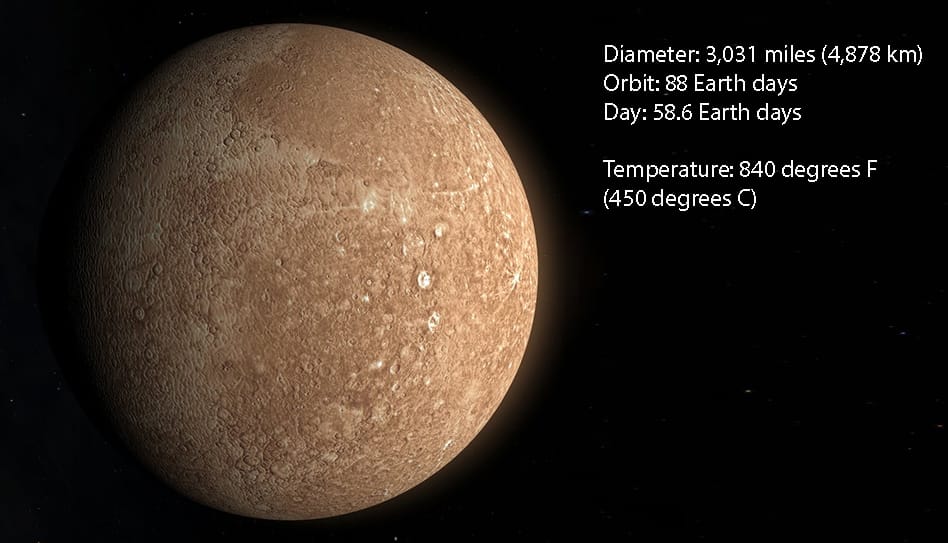
The closest planet to the sun is Mercury. This planet is only a little bit larger than Earth's moon. The sun scorches Mercury’s surface during day time, heating it to over 450 degrees C. During night time however, the temperatures drop to hundreds of degrees below freezing. The reason for this is because Mercury has almost no atmosphere to keep its surface temperature constant. An atmosphere also helps to absorb meteor impacts, and since Mercury doesn’t really have one, its surface is pockmarked with craters.
- Diameter: 3,031 miles (4,878km)
- Orbit: 88 Earth days
- Day: 58,6 Earth days
- Temperature: 840 degrees F (450 degrees C)
Venus

Although Venus is the second planet from the sun, its surface is even hotter than Mercury’s! This might seem very strange considering Venus is farther away from the sun. The difference between them is due to the fact that Venus has a very thick atmosphere. Sunlight and heat that reach Venus’s surface is kept in by the atmosphere like a layer of insulation. This is similar to the greenhouse effect on earth. Other features of Venus include its enormous pressure on its surface, and its toxic rainfall.
- Diameter: 7,521 miles (12,104km)
- Orbit: 225 Earth days
- Day: 241 Earth days
- Temperature: 472 C (882 F)
Earth
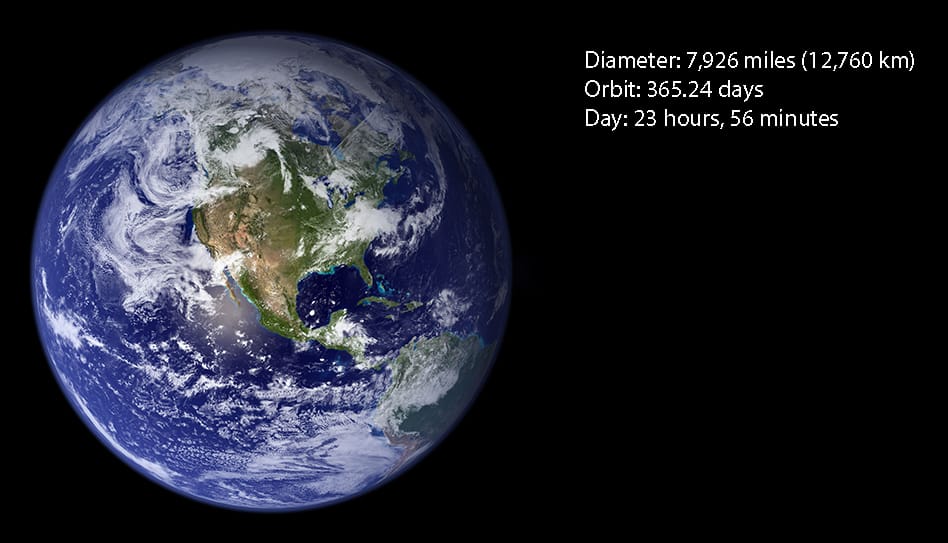
Earth is the third planet from the sun, and it is the only planet that is known to harbour life. It has several distinct features that allow organisms to live. Earth’s atmosphere is rich in life-sustaining nitrogen and oxygen. It is also covered by two-thirds of ocean. Earth's surface rotates about its axis at 1,532 feet per second — slightly more than 1,000 mph — at the equator. The planet zips around the sun at more than 18 miles per second.
- Diameter: 7,926 miles (12,760km)
- Orbit: 365,24 days
- Day: 23 hours, 56 minutes
Mars
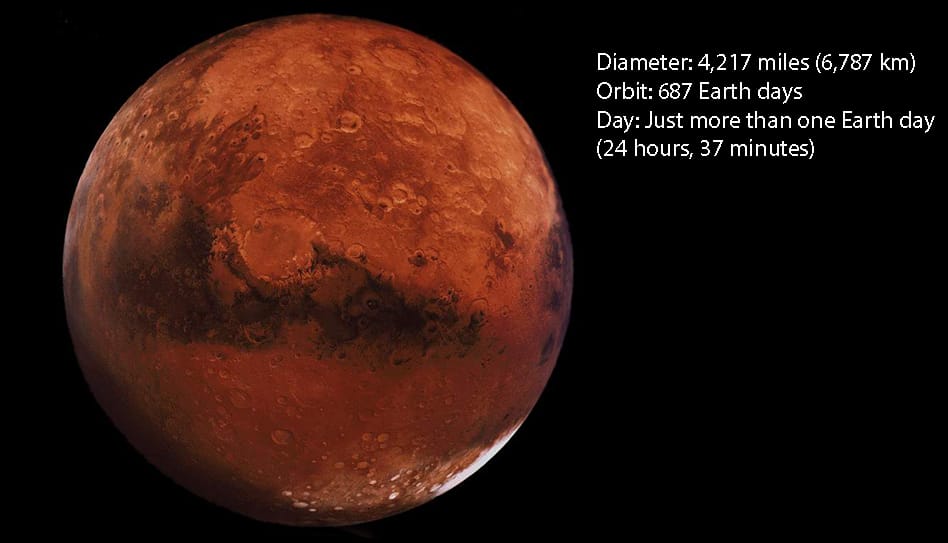
Mars is the last of the terrestrial planets in our solar system. It is a cold planet full of iron oxide dust, which also gives it a reddish-brown colour. Mars actually shares many similarities with Earth. It has many mountains and valleys, and it has two polar ice caps made of water. Scientists think it might have once supported life when it was warmer.
- Diameter: 4,217 miles (6,787km)
- Orbit: 687 Earth days
- Day: Just more than one Earth days (24 hours, 37 minutes)
Jupiter
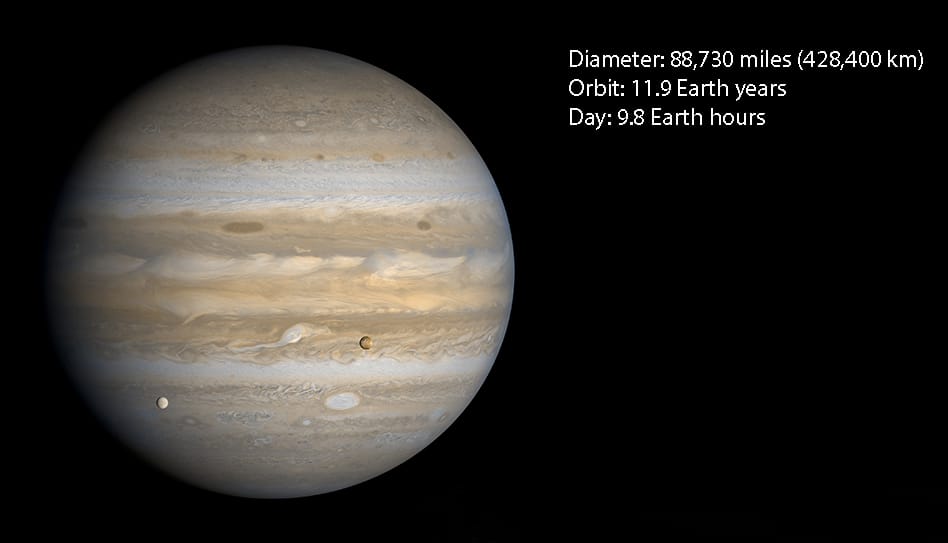
Jupiter is the first of the gas giants. It is the largest planet in our solar system, and consists of mainly hydrogen and helium. Its colourful, swirling clouds come from the different types of gases. A big feature is the Great Red Spot, a giant storm which has raged for hundreds of years. Jupiter has a strong magnetic field, and with dozens of moons, it looks a bit like a miniature solar system.
- Diameter: 88,730 miles (428,400km)
- Orbit: 11.9 Earth years
- Day: 9.8 Earth hours
Saturn
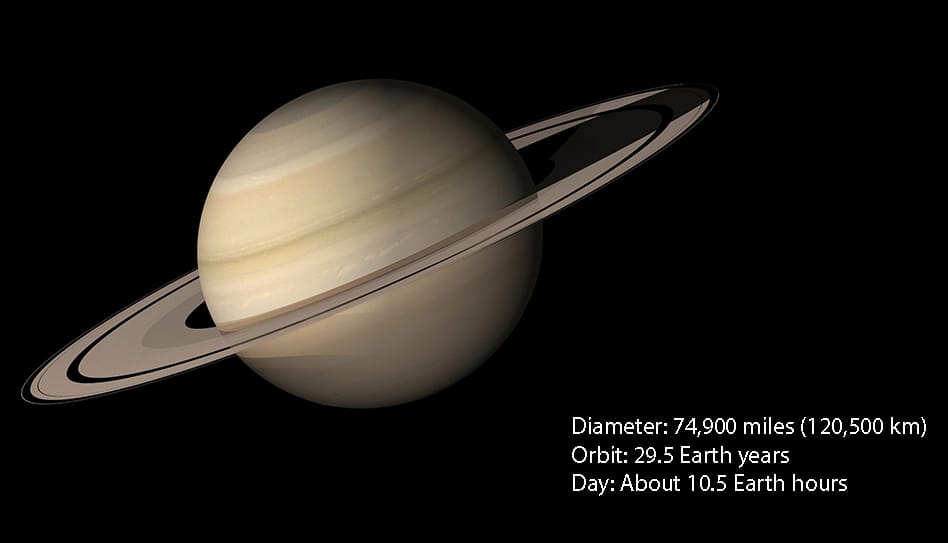
Saturn is the 6th planet of the solar system. It is also a gas giant like its brother Jupiter, and it consists of mainly hydrogen and helium. It’s famous for its pearlescent yellow surface and magnificent rings. The rings are made of ice and rock.
- Diameter: 74,900 miles (120,500km)
- Orbit: 29.5 Earth years
- Day: About 10,5 Earth hours
Uranus

Uranus is the 7th planet from the sun. It is strange because it is the only giant planet whose equator is nearly at right angles to its orbit. This means Uranus basically orbits on its side! Astronomers think the planet collided with something equally large a long time ago, causing the dramatic tilt. Methane in its atmosphere gives Uranus a blue-green colour.
- Diameter: 31,763 miles (51,120km)
- Orbit: 84 Earth years
- Day: 18 Earth hours
Neptune

Neptune is the last (8th) planet from the sun. It is known for its strong winds, which are sometimes faster than the speed of sound. Neptune is freezing cold, and although it is considered a gas giant, it has a rocky core.
- Diameter: 30,775 miles (49,530km)
- Orbit: 165 Earth years
- Day: 19 Earth hours
Pluto (Dwarf Planet)

Pluto is unlike other planets in many respects. It is smaller than our moon, and its orbit carries it inside the orbit of Neptune. From 1979 until early 1999, Pluto had actually been the eighth planet from the sun. Then, on Feb. 11, 1999, it crossed Neptune's path and once again became the solar system's most distant planet. It was then demoted to become a dwarf planet status.
- Diameter: 737 miles (1,186km)
- Orbit: 248 Earth years
- Day: 6.5 Earth days
Exercise
Open the exercise to begin the activity. Follow the instructions in the document.